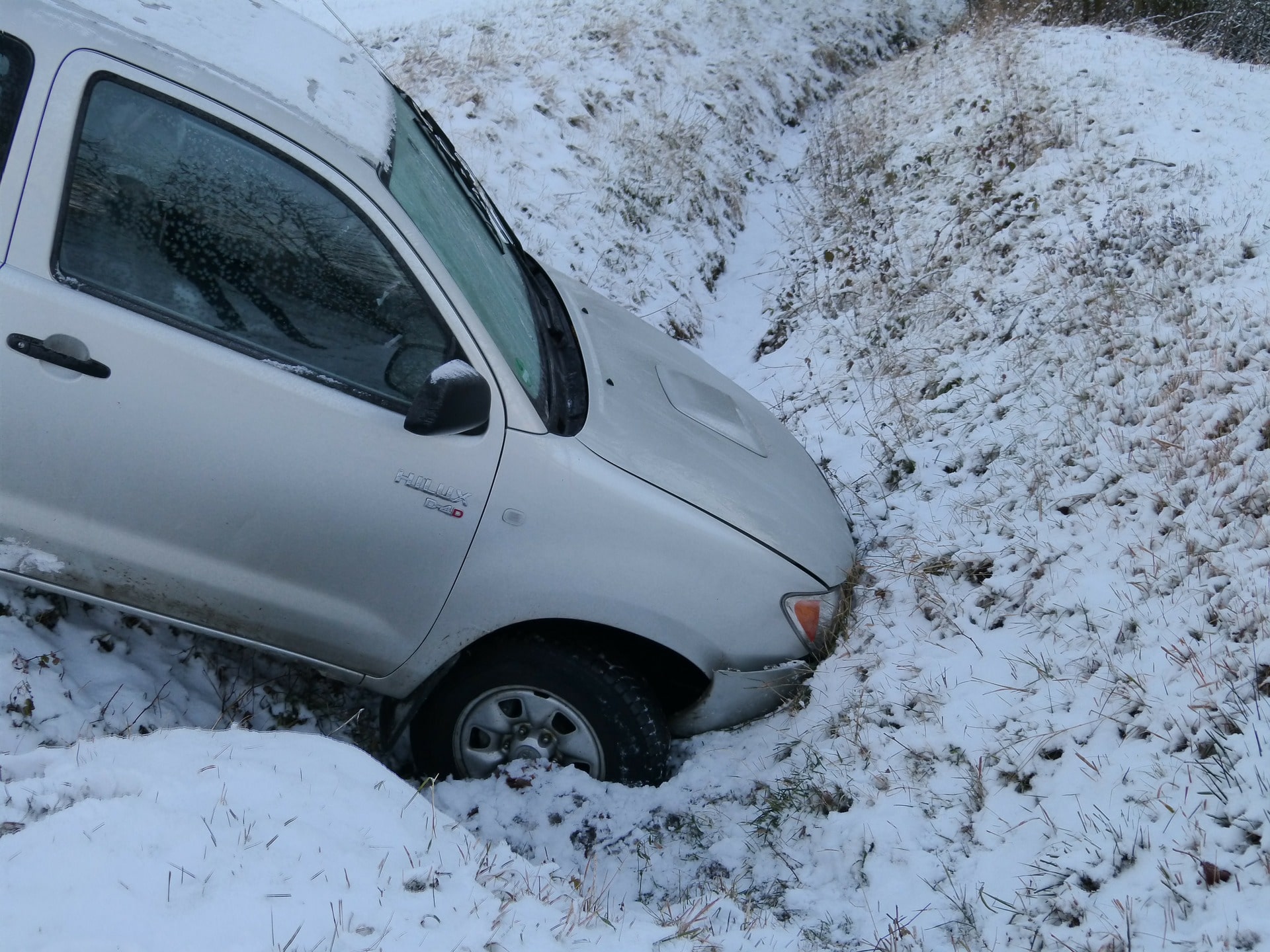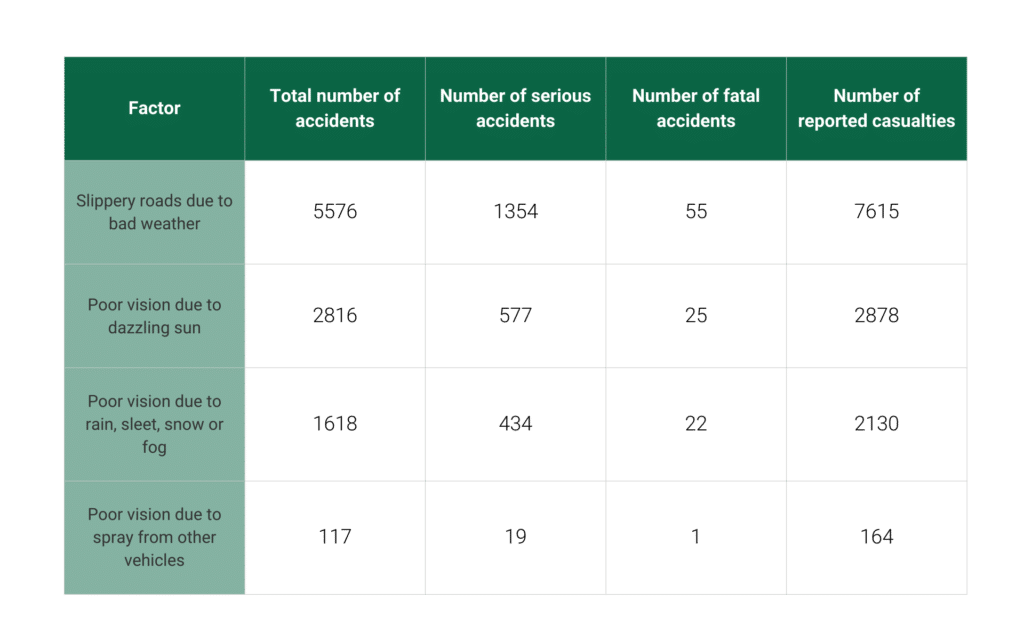Winter is coming…
Across the UK, drivers are experiencing a large drop in temperature, heavy rain, icy roads and spray from other vehicles when they travel. All of these conditions make it harder to see, increase reaction times to hazards, and can make the stopping sight distance greater than the visibility distance.
It becomes more challenging for fleet drivers to complete their journeys safely and without incident if appropriate measures aren’t adopted. This puts the health of themselves and others at risk, alongside the likelihood of expensive insurance claims.
So, as a fleet manager, how can you reduce the risk of winter accidents in your fleet?
Find out what winter driving solutions you can implement to manage your fleet effectively, reduce risk and improve efficiency in our handy guide:
Winter Driving Accidents

Winter brings many challenging weather conditions which make it more difficult to drive safely and easier for accidents to occur. Heavy rain, snow, ice patches, low winter sun, increased spray from wet roads, crumbling potholes, fog and flooding are only a few difficult conditions that your drivers will have to face on the road.
Even for cars, stopping distances double in wet weather and increase tenfold in icy and snowy weather. On average, a car travelling under ideal conditions at 65 miles per hour will take 96 metres to stop, whereas a fully loaded tractor-trailer will take 160 metres to stop. This means that stopping distances for HGVs can come up to 320 metres in the rain and a massive 1600 metres in icy weather.
“Heavy rain, snow, ice patches, low winter sun, increased spray from wet roads, crumbling potholes, fog and flooding are only a few difficult conditions that your drivers will have to face on the road.”
The rain and spray from other vehicles on the road decrease visibility and make it easier for your drivers to miss important road signs such as ‘give way’ or ‘stop’ while winter driving. Combined with the longer stopping distances, these conditions make it too easy for drivers to overshoot a junction and crash. Aggressive drivers, who are more prone to harsh acceleration and harsh breaking, are also at more risk in the winter and are much likelier to get into accidents due to the frictionless roads.
According to the Department of Transport[1], these were the number of accidents that occurred due to winter weather in 2019:

In total, the environmental factors caused by winter weather caused 9,497 accidents and 12,787 reported casualties.
So, what can you do to prevent accidents in your fleet and protect your drivers?
“In total, the environmental factors caused by winter weather caused 9,497 accidents and 12,787 reported casualties.”
Winter Driving Solutions: Educate Your Drivers
Educating your drivers on essential winter driving tips is the first step in accident prevention. FORS outlines three key points that your drivers should consider to keep themselves safe this winter:
1. Check the forecast
Drivers should always check the Met Office for the weather forecast before beginning their journey to see if they’ll be affected by bad weather, plan their route thoroughly and check where they can stop for breaks. The severe winter weather may increase their journey time, so checking the forecast will also determine whether they need to take extra breaks and inform customers of any delays.
2. Check your vehicle
It’s always vital for your drivers to conduct daily walkaround checks for their vehicles before any journey to ensure that it is safe to drive. They should thoroughly check the inside and outside of the vehicle to make sure that everything is in working order. For HGVs, you can see what should be included in daily checks in this government guide and there’s also a handy video for drivers from the Driver and Vehicle Standards Agency.
“It’s always vital for your drivers to conduct daily walkaround checks for their vehicles before any journey to ensure that it is safe to drive.”
According to FORS, it’s particularly important in the winter for your drivers to check:
- Tyre tread
- Frozen brakes
- Windows, windscreen wipers and mirrors
- Fluid levels
- Exhaust
- The vehicle and trailer body
3. Plan for hazardous conditions
In winter weather, your drivers need to pack the right equipment to prepare for any situation.
Here is the list of equipment that FORS recommend should be carried:
- De-icer and an ice scraper
- Warm clothing including boots, hat and gloves
- Torch
- A shovel and a bag of salt or sand
- A road atlas
- Extra food and drink
- A mobile phone charger or charging bank
We suggest that you send your drivers the following resources so that they can familiarise themselves with winter driving tips and ensure that they are safe over the next few months:
- FORS’ Winter Guide for HGV Drivers
- Highways England – Driving in Severe Weather
- HGV Driving Safety Tips for Snow and Ice
~
Winter Driving Solutions: Useful Tools to Reduce Fleet Risk This Winter
Using Fleet Risk Management software is the perfect way of increasing your fleet’s efficiency and building stronger relationships with your insurers at any time of the year, but especially at winter time.
Rich data tools such as VUEanalytics allow you to view your fleet’s telematics alongside claims data and contextual data such as weather and road surface quality. Easy-to-understand charts display data across several areas including:
- Overall fleet performance
- Best and worst performing drivers
- Individual driver performance
- Fleet performance against your KPIs
- Correlation between driver behaviour and claims data
“Using Fleet Risk Management software is the perfect way of increasing your fleet’s efficiency and building stronger relationships with your insurers at any time of the year, but especially at winter time.”
Unlike regular telematics, VUEanalytics displays contextualised telematics data that is far more advanced than location, speed, sudden breaking, acceleration and cornering. Using the software, you’ll be able to see whether your drivers are taking the proper precautions to drive safely in winter weather environments. The difference with VUEanalytics is that it takes into account weather (when drivers are in areas with sleet, snow or fog) and road surface factors, showing you if your drivers are travelling too fast for conditions, overshooting junctions or disobeying ‘give way’ or ‘stop’ signs on slippery roads. This gives you an accurate picture of your fleet’s winter performance and your risk portfolio. Most importantly, it allows you to pinpoint what solutions you can put in place to reduce risk.
Depending on the issues you uncover, potential solutions include:
- Selecting a different route
- Reducing the number of trips
- Using different start and end points/depots, if possible
- Implementing warning or penalties for certain drivers
- Establishing more rest breaks
- Implementing further driving training/intervention training on increased risk situations (including using video telematics footage)
Using the individual driver performance feature, you can also reward drivers with good behaviour and encourage improvement in those who need it to champion great driver behaviour across your fleet.
In short, using VUEanalytics this winter will allow you to monitor the overall performance of your fleet in greater detail than normal telematics, so you can quickly identify areas that need improvement and take action to reduce risk.
Winter Driving Solutions to Resolve Claims Quickly
Adopting accident prevention measures is the best way to reduce risk, but to prepare for the worst, you should consider fitting your fleet with video telematics equipment to help resolve claims quickly.
Our Video Telematics solutions features enhanced DVR recorders with 4G connectivity that can be fitted to all types of vehicles in your fleet. The VMC2 is a dashboard cam and telematics recorder perfect for cars and small vans. The VMC4 has four video inputs and is ideal for larger vans and LGVs. The VMC8 has eight video inputs and is the perfect choice for larger and articulated HGVs.
All of the video footage and telematics data for your entire fleet can be accessed through our web-based portal; VUEhub. In the event of an accident, video can be remotely downloaded from the precise time or location of an incident. This video footage can then be used to refute any false claims made against your drivers and to resolve genuine claims quickly.
“Adopting accident prevention measures is the best way to reduce risk, but to prepare for the worst, you should consider fitting your fleet with video telematics equipment to help resolve claims quickly.”
VUEhub provides:
- Live viewing through the cameras fitted to your vehicle
- Remote downloading of video footage
- A full telematics suite that includes historical replay, geo-fencing and driver behaviour, which feeds into reporting tools
- Scheduled reports
Using VUEcloud you can instantly upload and share CCTV video footage with your insurers to help them settle claims quickly and efficiently.
Talk to the team today, email them using hello@vue-cctv.co.uk or give them a ring on 0161 877 2257.
________________________________________________________________________________________
References
[1] data from RAS50001: and RAS50007:

